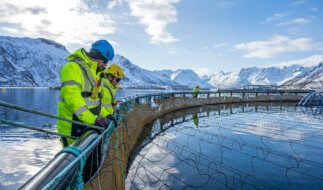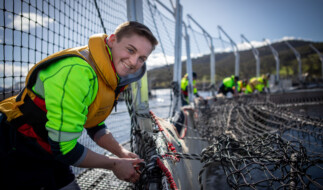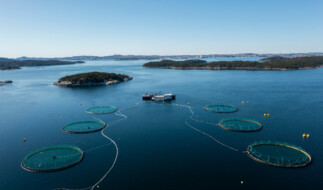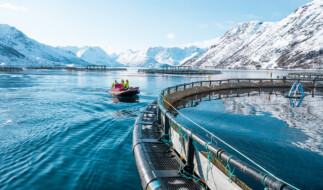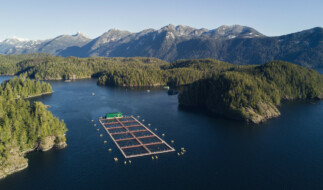Billionaire Island: Fact vs. Fiction in Salmon Farming
Salmon Welfare Environmental Sustainability

Global Salmon Initiative discusses the comparisons between the Netflix drama “Billionaire Island” and real-life salmon farming.
Set on a small Norwegian island, the new Netflix drama series "Billionaire Island" tells the fictional story of two rival families in the salmon farming business. Echoing the popular drama "Succession," the show centers around a hostile takeover, with one CEO's ruthless ambition to become the world's largest salmon producer, regardless of the family fallout. While the series offers gripping entertainment, it's important to remember that it is just that—entertainment.
In this blog, we will dissect the themes presented in the show and compare them to the realities of the salmon farming industry:
- Are all salmon farming companies family-owned and competitive?
- Are there often sabotage attacks from competitors that lead to salmon escapes?
- How does the activism in the show compare to real life?
- Sustainability vs. profit: do CEOs need to choose?
Please note, if you haven't watched the series yet, this blog contains spoilers!
Are all salmon farming companies family-owned and competitive?
The series follows two multi-generational family-owned salmon farming companies, Marlax and Meyer Fjordbruck, embroiled in conflict over a potential merger. The plot delves into the intricate politics of family dynamics and the drama among the CEOs' children vying for power. While this makes for compelling television, is it a true reflection of the salmon farming industry?
The salmon farming industry indeed has deep family origins, with the passion for salmon farming being passed down from generation to generation. For many involved, it truly is a way of life, not just 'work.' While there are still many generations of families working in the sector, the reality is that salmon farming companies are far more sophisticated and complex than the show suggests.
Like many businesses, the variety of roles and skills required—from farmers and scientists to data and administration specialists—means that companies seek the support and input of thousands of individuals around the world (over 27,000 employees from GSI members alone!). While a number of the world’s salmon farmers have remained privately owned, many are now publicly listed, adhering to rigorous guidelines for transparent business and financial disclosures.
Hear from Nina Willumsen Grieg, Regional Director of Grieg Seafood Rogaland, as she describes the people working at Grieg.
Are there often sabotage attacks from competitors that lead to salmon escapes?
A major storyline in the series features Meyer Fjordbruck’s orchestrated attack on Marlax’s facilities. In a retaliatory move to prevent the acquisition, the CEO’s daughter and her husband pay a local diver to cut open a salmon pen, leading to a massive farmed salmon escape around the island.
In reality, no salmon farmer wants fish to escape, whether they are competitors or not. Escape incidents are rare in the salmon farming industry, and companies take extensive measures to prevent them in order to minimize the impact on wild salmon populations and the surrounding ecosystem. While escapes can occur due to extreme weather, predation (e.g., a seal biting through netting), or human error, they do not commonly happen, and certainly not due to attacks from competitors. In the rare event that escapes do occur, GSI members track and report all incidents to authorities and include them in our annual Sustainability Report for transparency, raising awareness and helping to prevent future escapes.
Watch as Roger Pedersen, Grieg Seafood, discusses the company’s efforts to reduce fish escapes and be mindful of local environments and wild populations.
How does the activism in the show compare to real life?
Another plotline in the show features the upheaval caused by an animal rights group targeting an international music group because of their alignment with the industry, including a performance for the daughter of the Marlax CEO at their home in Norway. This drama leads her and her friends to question whether or not fish have feelings.
Since the inception of salmon farming, significant advancements have been made to improve the welfare of the fish we raise. Following scientific studies, we now understand that fish can experience stress, which is why we strive to provide optimal living conditions throughout all phases of a salmon’s life cycle. Welfare standards for fish are just beginning to emerge, and ongoing research will continue to drive improvements to ensure the highest standard of care.
Within GSI we take the topic of fish welfare incredibly seriously, which is why we have a dedicated expert taskforce on the matter. The group unites fish health experts from around the world to discuss and share best-practices, innovations and learnings as new information becomes available to support the continuous improvement of animal welfare practices. In addition to this, our members also work with multiple certification schemes such as Aquaculture Stewardship Council (ASC) which has specific metrics to monitor and benchmark welfare performance.
Sustainability vs. profit: do CEOs need to choose?
Throughout the show, sustainability priorities were dismissed by one of the CEOs in favor of profit and growth. In the last episode, sustainability champion Amy Lange, the eldest daughter of Marlax CEO, Julie Lange, states “my experience is that people in the business have an outdated idea that profit and sustainability aren’t compatible,” a sentiment she seeks to prove wrong.
In reality, CEOs don’t need to choose between sustainability or profit. In fact, executives are realizing that sustainability should not be isolated from business growth; instead, the two go hand in hand. According to McKinsey, companies that integrate environmental, social, and corporate governance (ESG) priorities into their strategies and focus on improving revenue and growth outperform their competitors. The same holds true in salmon farming. Simply put, to maintain a healthy business, we must raise high-quality salmon. Our fish need to be fed an optimal and sustainable diet and live in a healthy environment, with the smallest footprint possible.
GSI member companies understand the need for sustainability improvements in the industry and are committed to transparently reporting on progress and addressing key sustainability challenges. Through efforts such as GSI’s Sustainability Report, and our ESG Feed Risk Assessment Tool developed in partnership with World Wildlife Fund, our mission is to advance industry sustainability at speed and scale.
For any other questions about salmon farming operations, or farmed salmon visit our Frequently Asked Questions.
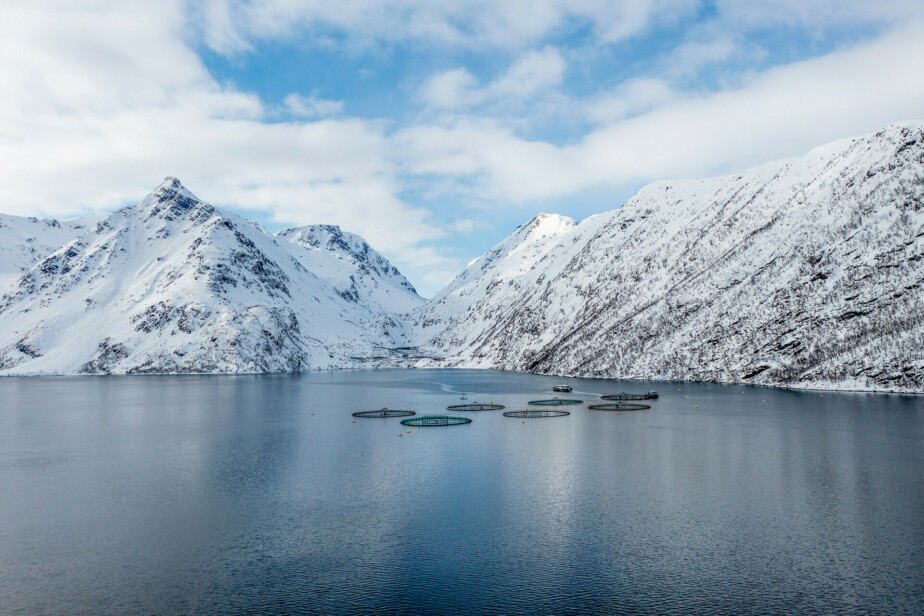
Grieg Seafood, Alta, Norway
While several themes in the series may have been exaggerated, one aspect that reigned true was the stunning fjord landscape shots in Norway. We can confirm that since salmon farm sites are typically located in remote areas, they make for beautiful views, like this one above from our member, Grieg, in Alta, Norway.
Overall, this fictious and dramatized take on the farmed salmon industry was enjoyable for us to indulge in. The season ended with a notable cliff-hanger which may be setting up for a second season of the series. Will you be watching?
